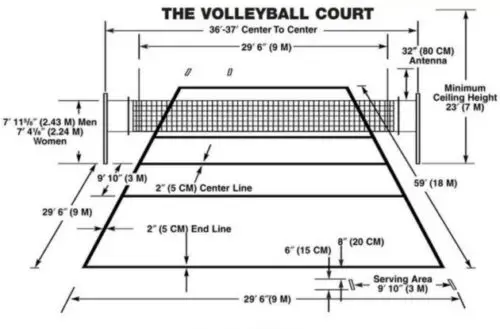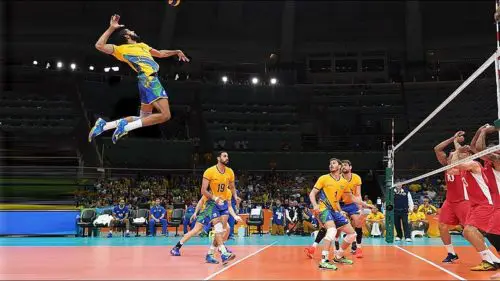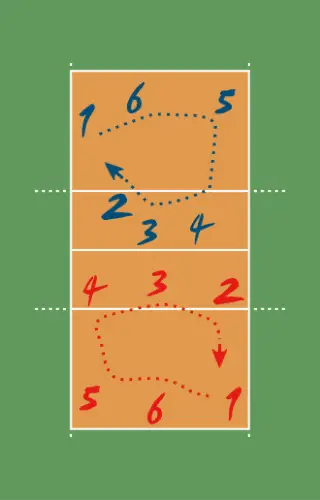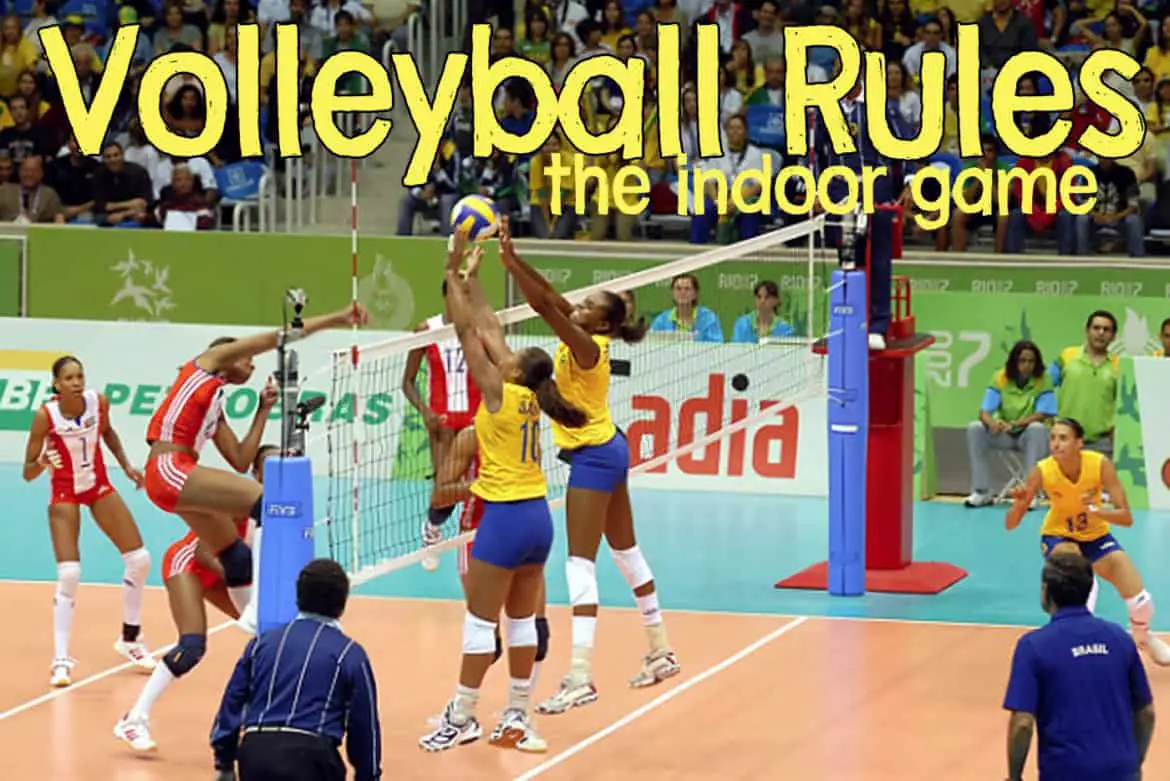Rules of Volleyball
As a 6’6″ man, I was, and am, constantly asked if I played basketball and/or volleyball. While basketball is not my forte, I have always enjoyed playing volleyball and getting to use my height for something fun and active.
One of the best things about volleyball is that it is a sport that is easy to pick up and play with friends, yet also technically difficult enough to keep professional athletes, and audiences, engaged.
The rules are also almost exactly the same for both men and women, allowing for friends to start a pick-up game wherever they are.
General Set-Up
- Each team can only have 6 players on the court at one time – 3 in the front and 3 in the back. The position in which you start is important because breaking the rotation results in the other team gaining a point.
- The Court size is 18 by 9 meters (59 by 29 feet) and this is the same size for FIVB (Fédération Internationale de Volleyball or International Volleyball Federation), the Olympics, NCAA, and High School. It is also the same for men and women.
- The height of the net is one of the only differences between men’s and women’s volleyball. The top of the net is 2.43 meters, or 7 ft 11 11⁄16 in, high in a men’s game, and 2.24 meters, or 7 ft 4 3⁄16 in, high in a women’s game.
- Volleyball matches are made up of sets. The number of sets depends on the level of play, although after Junior Varsity games in High School, almost every level above that are 5-set matches. If you are playing in a 5-set match, 4 sets are played to 25 points and the 5th is played to 15. The first team to win 3 sets is the winner. If you are playing in a 3-set game, then 2 sets are played to 25 with the 3rd being played to 15. The first team to win 2 sets is the winner.
- Teams must win by 2 points, no matter which set it is (whether it’s the first or the last) to win the set.

Basics Rules
We’re going to go through the rules as if you were watching a rally from start to finish, or in this case from service to point. Breaking any of these rules results in the other team gaining a point.
- The server must serve the ball from behind the court line, but he can serve from anywhere along that line.
- After the serve, the players in the front can switch positions at the net.
- Each side can only hit the ball up to 3 times before they must attempt to hit it over the net to the other side.
- If the ball is blocked back onto a side, the 3-count starts over.
- You may use any part of your body to hit the ball, although the arms and hands are the most popular and plausible.
- If the ball hits the net, during a serve or rally, it is still able to be played off of, unless during the serve the ball doesn’t make it to the other side.
- If the ball touches the line it is in.

Backcourt spike
Rule Violations
All of these result in an automatic point to the other team
- The server stepping on or over the backcourt line during his or her service.
- Players can’t block a serve, and must receive it from behind the 10-foot line (middle line).
- You can’t hold, throw, or lift the ball. A lift is when you flick your wrist with the ball in the palm of your hand.
- When blocking, you can’t touch the ball when reaching over the net if both your opponent has not used 3 contacts and they have a player there to make an attempt at the ball.
- When attacking a ball coming from the opponent’s side, reaching over the net to touch the ball is a violation if the ball has not yet broken the vertical plane of the net.
- Players can’t hit the ball twice, in succession. They can hit it first and third, but this is uncommon.
- The ball can’t hit the poles on either side of the net.
- If the ball completely outside the boundaries of the court, than it is a point for the other team, and the rally ends.
- Players can’t touch the net if the ball is in play.
- No part of the player’s body can cross the line under the net, unless it is only a part of your hand or foot.
Now that we have a general understanding of what players can and can’t do, let’s turn our attention to the players and their specific roles within the match.
Players and Positions
First let’s start off with the libero. This position was actually introduced 20 years ago by the FIVB. This position has a few different characteristics that set it apart from the rest of the positions.
First, the player wears a jersey that is a different, usually contrasting, color from the rest of the team. Second, the libero can’t serve, spike the ball over the net, or rotate into the front-line positions.
Third, the libero is the primary receiver of the serve from the other team.

Adding the specific position of the libero to the game has allowed for teams to have better serve reception and backcourt defense, which has led to longer volleys, more intense playing, and specific spot for shorter people.
Next we have the setter. This position is kind of like the quarterback or the point guard, as the setter is in charge of running the team’s offense.
They also play a fundamental role in the team’s offense be being the one to pass the ball to those who hit it to the other side, also known as hitters.
Setters need to be versatile players since they play in the front and back, so they need to be able to block, serve, and play defense, alongside running the offense. Normally the setter plays the right front or the right back position.
The outside hitter is another position where a versatile player is needed, as one must be able to receive the serve if the libero can’t and attack the ball.
After the serve, this player moves to the left front position so that the setter can set, or pass, them up to hit the ball across the net.
Sometimes the outside hitter will run an offensive play that causes them to hit the ball “inside,” or around the middle blockers. Outside hitters usually play in both the front and back row.
Another position is the right side hitter, or wing spiker. The player who plays this position needs to have the skills to attack, block, serve, pass, and play defense.
This position is similar to the outside hitter, but due of their position, in the right front position, they tend to score far more than the outside hitter.
Not to be confused with the outside hitter, the opposite hitter is a completely different position.
While this position does not have any passing responsibilities, they are still a crucial part of the team. They stand being the passers and wait for their opportunity to hit, or attack, the ball over the net.
The player in this position tends to score the most and receive the most amount of sets. When on defense, this position is responsible for blocking any incoming hits from the opposing team.
One of the last positions is the middle blocker, which could also be called the center, middle, or middle hitter. This position’s main responsibility is to stop the opponent’s offense.
The player in this position is tasked with guarding the net, setting up blocks, and hitting the ball. If the libero is the shortest person on the team, then the middle is typically the tallest.
While the libero spends all of their time in the back row, the middle spends all of their time in the front row. As such, they tend to not be the best at back line defense and hardly ever spend any time in the back row.
I hope this overview gives you a solid foundation moving forward with understanding volleyball, whether you are a player, parent, or burgeoning fan.
To find out more about some basic equipment you’ll need, you may want to check out some of these reviews;
Our best volleyball picks, Volleyball Kneepads and Shoes!

